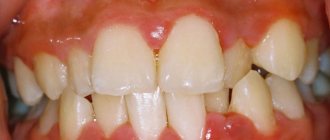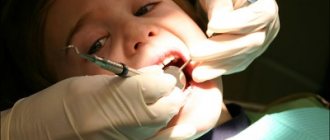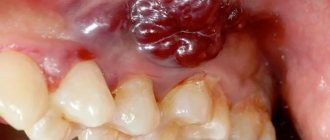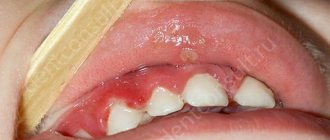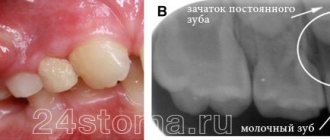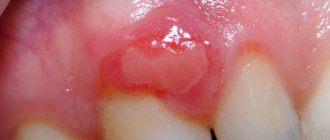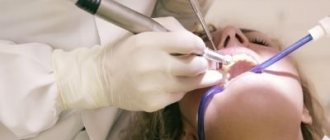An abnormality such as bone spurs is often ignored until it actively progresses. Patients often come to the clinic late, which entails complex treatment, including surgery. Exostosis is a pathology in which hardened areas of cartilage tissue protrude above the jaw are formed. The causes of this phenomenon are mechanical damage, trauma, tooth extraction and other diseases. Chewing functions are preserved, and soft tissues are also not damaged. But as the protrusions grow, thinning of the mucous membrane and ruptures occur, causing injury to surrounding areas.
Causes
Reasons for the formation of growths:
- inflammatory, infectious processes, purulent accumulations;
- mechanical impacts, injuries causing bone destruction, jaw displacement and other damage;
- deviations of row segments, formation of nodular hardenings;
- disorders of the endocrine system, hormonal levels.
One of the reasons for the development of pathology is complex tooth extraction. Often, when a wound heals, the tissue around it becomes overgrown with moving areas. If done incorrectly, compactions may appear and exostosis will gradually develop.
Treatment of cones
The treatment methodology depends on the specific case. The approach is determined by:
- the presence of pain;
- part of the cavity that has been infected (upper, lower);
- time elapsed since the onset of the disease;
- reaction of the cone to pressure.
Treatment of angioma
Removing a lump of this type occurs in three stages:
- Drug treatment and treatment;
- Surgery;
- Radiation therapy.
At the first stage, alcohol is used: it constricts blood vessels and helps eliminate high blood loss during surgery.
Then, in the case of the capillary form, radium therapy is used, it consolidates the effect of treatment, and sometimes can act as an independent drug and cure the disease completely.
It is prohibited to treat the cavernous form of angioma with radium. It can help transform the lump into a malignant one, which can greatly worsen the patient’s condition.
Treatment of pemphigus
A lump of this type that appears on the palate is treated mainly with antibiotics and a diet that includes a high content of proteins and vitamins, but without salt .
If such a lump appears, it is necessary to use disinfectant solutions. In severe forms, blood transfusions are used.
Treatment of myxoma and cysts
In these forms of the disease, the attending physician prescribes antiseptic drugs and prepares the cavity for surgery (if there are signs of accelerated growth of the lump into the tissue).
Additional methods of electrical treatment are also used, which make it possible to artificially kill tissue without the use of a scalpel, but all methods of this type are dangerous, thanks to them, a malignant formation may appear in place of a benign one.
Treatment of cancer
Cancer requires immediate intervention by a qualified specialist. The earlier the stage of the disease, the less harm the treatment and the disease itself will cause to the body. If a cancer lump appears, the following treatment approaches are used:
- Radiation therapy – the cancerous growth is irradiated with X-rays. In the early stages, it completely cures the disease.
- Surgical intervention - not only the harmful lump is cut out, but also the tissue around it, in order to exclude relapses. Such an intervention leaves defects on the face, which can later be corrected with plastic surgery.
- Chemotherapy - taking cytostatics.
For the cancer in question, chemotherapy is effective only in combination with radiation and surgery.
It is easier to defeat any disease at its inception stage. But in the case of bumps on the palate, it is better not to have the disease than to treat it later.
The root causes of the disease have not been fully established. Therefore, following the hypothetically formed rules will not completely protect you from the disease, but it will definitely reduce the chance of developing a similar problem. A preventative visit to the dentist will ensure timely treatment, even if the lump pops up unnoticed.
Symptoms
The initial stage of the pathology practically does not manifest itself. Symptoms generally have a vague picture, which is why patients rarely see a doctor in a timely manner. But as the condition worsens, the following symptoms appear:
- growths with a pronounced convex shape appear on the tissues; the structure can be embossed or smooth;
- there is a feeling of a foreign object in the mouth;
- pain appears, sometimes quite severe;
- partial jaw dysfunction is observed;
- the shade of the mucous membrane changes to bright;
- capillary obstruction appears in the area of the growth.
Types of tumor
A tumor on the roof of the mouth always indicates the onset of an inflammatory process in the human body. Tumors can be benign or malignant.
Malignant formation
Problems with the development of a malignant tumor are not limited to disturbances in speaking and eating. The lump, the cause of which is cancer, impairs articulation, complicates the ability to communicate or completely eliminates it.
Oral cancer is typical for men and is a local metastasis of other malignant tumors in the head. It is a rare cancer.
Such malignant lumps are classified as growths on the roof of the mouth. The tubercle can pop up due to a benign inflammatory process, so it is impossible to express a clear opinion about the diagnosis.
Understanding the reasons for the appearance of a tumor is important for determining the course of treatment. The causes can be accurately diagnosed by conducting clinical studies of the compaction.
Benign formation
A cyst on the roof of the mouth is not a fatal diagnosis; it is diagnosed with a number of benign tumors. Such tubercles are caused by insidious but curable diseases:
- growth of blood vessel tissue (angioma);
- cyst;
- pemphigus (erosion);
- myxoma.
Indications and contraindications
The growth is treated surgically. Indications for using this option for removing pathology are:
- the bone growth grows quickly;
- pronounced cosmetic changes, progression of pathology;
- physical discomfort, the growth becomes too large;
- before prosthetics.
There are a number of the following contraindications to surgical intervention:
- pathologies of the endocrine system;
- adrenal dysfunction;
- diabetes of any form;
- bleeding disorders.
Treatment
Before treatment, the doctor conducts an examination and prescribes a number of diagnostic measures. It is necessary to perform fluoroscopy, determine the level of blood clotting, and determine whether there are contraindications to surgery. If there are no contraindications, the doctor removes the growth:
- anesthesia is performed (for uncomplicated pathology, the operation is performed under local anesthesia);
- the oral cavity is treated with antiseptic drugs;
- an incision is made on the gum, then the mucosal tissue is dissected to open access to the bone;
- the growth is removed using a laser beam or chisel (depending on the state of the pathology);
- the bone tissue is smoothed to an even texture, at which time cooled water is supplied to the surface;
- The tissues are sewn together and a bandage is applied.
The duration of the procedure depends on the complexity of the treatment. For mild cases, the operation takes about forty minutes; for complex pathologies, removal may take an hour and a half.
During the recovery period, the patient must follow the doctor's recommendations. For the first day, the intake of food and solid foods is limited, smoking and drinking alcohol are excluded. It is necessary to avoid physical activity, which can provoke bleeding and cause swelling.
Diagnostics
The defect rarely manifests itself with clinical symptoms. Most often, growths are discovered during the diagnosis of another disease. The doctor makes a diagnosis based on the patient’s complaints, the results of a clinical examination, and an x-ray. On an orthopantomogram or x-ray, the spines look like a formation not fused with the mucous membranes with clear boundaries.
Stages and methods of treatment
Exostosis of the jaw bone is treated surgically. There are two methods of manipulation. The choice of technique is determined by the location of the defect.
Removal of the palatine torus:
- small linear incision;
- detachment of the mucoperiosteal flap;
- excision of the growth with a block or sawing to remove pieces;
- revision of the wound, return of the gum flap and suturing of the wound.
The procedure for excision of alveolar osteophytes involves the surgeon performing the above actions. The difference lies in the technique of making the cut. The doctor makes an incision in the gum in the shape of a trapezoid.
The surgical procedure is performed using a bur, laser, or piezo knife. During the process of excision of spines, the doctor removes the surface layer of the adjacent part of the periosteum. This is necessary to reduce the risk of re-formation of pathology. If the patient has a deficiency of jaw bone tissue, the surgeon creates a cavity during the intervention and places osteoplastic material into it. The wound is then stitched.
Complications
Failure to follow the recommendations of the treating dentist can lead to postoperative complications. There is a risk of sutures coming apart due to damage to the wound by hard food and the development of an inflammatory process due to ignoring hygiene rules. If negative phenomena occur, you must see your doctor.
Prevention
To prevent exostosis of the lower jaw, following simple rules:
- daily oral hygiene;
- timely clinical examinations by a dentist;
- avoiding jaw injuries;
- treatment of diseases of teeth and gums at the initial stage.
Dear patients, systematic self-diagnosis has been proven to be effective. It is necessary to independently examine the oral cavity for the presence of pathological formations, palpating the palate and the surface of the jaws.
Price
The price of surgical treatment is determined by the complexity of the clinical situation, the size of the exostosis of the upper jaw and the surgical technique. In most dentists, the procedure is performed on a turnkey basis and costs about 3,000 rubles. The price includes: anesthesia, surgeon's work, consumables and doctor's examinations.
What is exostosis (osteophyte)
Exostosis of the jaw externally looks like a pathological growth on the jaw, on the gum. Its structure is hardened cartilaginous tissue, a benign formation on the bone. Being small in size, it is inconspicuous and does not affect the condition of the soft tissues of the gums and the functionality of the jaw. As the growth increases, it becomes noticeable - it becomes painful and uncomfortable for the patient to open his mouth, and the mucous membranes become thinner. Removing the benign formation of new bone tissue is the only correct solution in this case.
How is exostosis removed?
We have found out the main causes and characteristic symptoms of the pathology, and now we will move on to consider questions about what to do and how to treat exostoses on the gums. The standard procedure includes the following steps:
- administration of local anesthesia,
- treatment of oral tissues with antiseptics,
- making a cavity incision on the gum to provide unhindered access to the bone formation,
- lump removal - can be done using a chisel tool or using a laser device,
- grinding bone fragments to give an even relief,
- applying sutures and a sterile dressing.
Without taking into account preparatory measures, the procedure itself lasts about an hour - provided that a laser is used. If the removal is carried out using standard tools, it will take more time - about 1.5-2 hours.
Exostosis on the gums - characteristic symptoms
In most cases, it is possible to diagnose the presence of an anomaly at an early stage only at an appointment with a dentist. With such problems, it is impossible to carry out implantation or install a prosthesis, and experts identify possible consequences of an advanced stage of pathology, including malocclusion and displacement of the chin. As the size of the growth increases, the accompanying signs of the problem become more and more apparent. The following are typical symptoms:
- the appearance of a convex-shaped neoplasm without any apparent reason,
- feeling of the presence of a foreign body in the oral cavity, causing discomfort when eating and pronouncing sounds - in severe forms of pathology,
- unpleasant painful sensations when pressed,
- if the formation has affected articular fragments, disturbances in the functionality of the lower jaw are possible,
- noticeable redness of the mucous membrane at the causative site.
Unpleasant sensations of the presence of a foreign body in the mouth
If you notice one or more of the above symptoms, you should immediately contact your dentist. The longer the patient delays treatment, the more pronounced and serious the consequences of such inaction will be.
